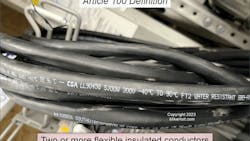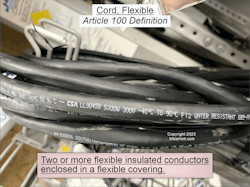Article 400 covers the general requirements and applications for flexible cords as contained in Table 400.4. Article 402 covers the general requirements for fixture wires.
Flexible cords
A “flexible cord” is two or more insulated conductors enclosed in a flexible covering [Art. 100] (Fig. 1).
The NEC does not consider flexible cords to be a wiring method like those addressed in Chapter 3 because they are not used as part of the wiring in the construction of a building.
Flexible cords (and their fittings) must be suitable for the use and location [Sec. 400.3]. The use of flexible cords must conform to the descriptions in Table 400.4. The suffix “W” at the end of a flexible cord type designates it is sunlight resistant and suitable for wet locations [Table 400.4, Note 9].
Flexible cords with conductor stranding other than Class B or C require the use of terminations specifically identified for the stranding in the flexible cord or cable [Sec. 110.14].
Table 400.5(A)(1) lists the ampacities for individual conductors inside manufactured flexible cords. Table 400.5(A)(2) lists the ampacities for overall cord assemblies with not more than three current-carrying conductors in an ambient temperature of not more than 86°F.
Uses permitted
Flexible cords within the scope of Art. 400 can be used for [Sec. 400.10]:
(1) Pendant boxes [Sec. 314.23(H)(1)], pendant lampholders, pendant luminaires, and pendant receptacles [Sec, 210.50(A)].
(2) Wiring of luminaires [Sec. 410.24(A) and Sec. 410.62(B)].
(3) Connection of portable luminaires, portable and mobile signs, or appliances.
(4) Elevator cables.
(5) Wiring of cranes and hoists.
(6) Connection of utilization equipment to facilitate frequent interchange [Sec. 422.16].
(7) Prevention of the transmission of noise or vibration [Sec. 422.16].
(8) Appliances where the fastening means and mechanical connections are specifically designed to permit ready removal for maintenance and repair, and the appliance is intended or identified for flexible cord connections [Sec. 422.16]. Appliances fastened in place cannot be connected by a flexible cord unless the appliances are specifically identified to be used with a flexible cord [Sec. 422.16].
(9) Connection of moving parts.
Attachment plugs are required for flexible cords used on portable luminaires, portable and mobile signs, or appliances [Sec. 400.10(A)(3) and Sec. 422.16]; utilization equipment to facilitate its frequent interchange [Sec. 400.10(A)(6) and Sec. 422.16]; and appliances specifically designed to permit ready removal for maintenance and repair and identified for flexible cord connection [Sec. 400.10(A)(8) and Sec. 422.16].
Uses not permitted
Unless specifically permitted in Sec. 400.10, flexible cords, cord sets (extension cords), and power-supply cords are not permitted for the following [Sec. 400.12]:
(1) As a substitute for fixed wiring.
(2) To be run through holes in walls, ceilings, or floors.
(3) To be run through doorways, windows, or similar openings.
(4) To be attached to building surfaces.
Exception to (4): Flexible cords used for temporary wiring [Sec. 590.4] may be attached to building surfaces.
(5) To be concealed by walls, floors, or ceilings, or above suspended or dropped ceilings.
Exception to (5): Flexible cords and power-supply cords are permitted if contained within an enclosure for use in other spaces used for environmental air as permitted by Sec. 300.22(C)(3).
(6) To be installed in raceways, except as permitted by Sec. 400.17.
(7) Where they are subject to physical damage.
Splices and connections
Flexible cords must be installed continuously without splices or taps in Sec. 400.10(A) applications [Sec. 400.13]. If the cord isn’t long enough to reach the receptacle from where the appliance is situated, you can use a longer cord, move the appliance, or install a receptacle closer to the location.
Flexible cords must be connected to devices and fittings so that tension is not transmitted to joints or terminals [Sec. 400.14]. This can be accomplished by knotting the cord, winding it with tape, or using support or strain-relief fittings. Generally, using a strain-relief fitting is the best option. It will result in a more professional look than knotting or taping. But there may not be a suitable strain-relief fitting readily available — or there may be some other reason to tape or knot.
Flexible cords must be protected by bushings or fittings when passing through holes in covers, outlet boxes, or similar enclosures [Sec. 400.17]. To avoid damaging the flexible cord jacket, use bushings or fittings suitable for the size of the cord.
If the strain relief, bushing, or fitting has a saddle clamp or similar, don’t tighten down on it so much that you squash the cord jacket. It merely has to be snug. For any such items, orient the screw heads to facilitate tightening (or loosening) the screws. Avoid positioning it such that special tools (such as offset screwdrivers) must be used. In many cases, a rotation of just 30 degrees makes the difference between a good installation and a bad one.
Fixture wires
Article 402 covers the general requirements for fixture wires (Fig. 2).
Note: See Part VI of Art. 410 for application in luminaires.
Fixture wires must be a type contained in Table 402.3 [Sec. 402.3].
Ampacity
The ampacities of fixture wires are in Table 402.5. They range from 18 AWG for 6A to 10 AWG for 28A. You may have noticed that the list doesn’t go below 18 AWG. Any wire smaller than that cannot be used as fixture wire [Sec. 402.6]. Also, note those are minimums; you are free to use a larger size fixture wire if it is compatible with the terminations and connectors being used.
Raceway size
Raceways must be large enough to permit the installation and removal of conductors without damaging the conductors’ insulation [Sec. 402.7]. The number of fixture wires in a single raceway must not exceed the percentage fill specified in Chapter 9, Table 1. When all conductors within a raceway are the same size and insulation, the number of conductors permitted can be found in Annex C for the raceway type.
Neutral conductor
Fixture wire used as a neutral conductor must be identified by continuous white stripes [Sec. 402.8].
Uses permitted
Fixture wires are permitted for [Sec. 402.10]:
(1) Installation in luminaires and similar equipment where enclosed or protected and not subject to bending or twisting in use.
(2) Connecting luminaires to the branch-circuit conductors.
You can also use fixture wires for elevators and escalators [Sec. 620.11(C)], and for Class 1 Power-Limited Circuits [Sec. 724.49(B)]. But you cannot use them for branch-circuit wiring [Sec. 402.12].
Overcurrent protection for flexible cords, flexible cables, and fixture wires
Flexible cords, flexible cables, and fixture wires must be protected from overcurrent by Sec. 240.5(A) or Sec. 240.5(B):
- Protect flexible cord and flexible cable with an overcurrent device based on their ampacity as specified in Table 400.5(A)(1) and Table 400.5(A)(2). Protect fixture wire against overcurrent as specified in Table 402.5. Supplemental overcurrent protection, as covered in Sec. 240.10, is an acceptable means of providing this protection [Sec. 240.5(A)].
- Protect flexible cord, where supplied by a branch circuit, per one of the methods described in Sec. 240.5(B)(1), (3), or (4). Protect fixture wire, where supplied by a branch circuit, per Sec. 240.5(B)(2) [240.5(B)].
The short version of those protection methods:
(B)(1). The cord is approved for and used with a specific listed appliance or luminaire.
(B)(2). The fixture wire is tapped to the branch-circuit conductor (AWG minimums apply).
(B)(3). The flexible cord is applied within extension cord limits.
B)(4). The flexible cord in extension cords with separately listed and installed components can be supplied by a branch circuit (20A circuits, 16AWG, and larger).
Avoiding problems
It’s helpful to keep in mind that the requirements for flexible cords and fixture wires are not in Chapter 3. For this reason, don’t try to use them as substitutes for Chapter 3 wiring methods. They are an adjunct to those methods, forming a bridge between premises wiring and certain types of utilization equipment.
When installing flexible cords and fixture wires, remember that a trade-off in gaining flexibility is you lose some of the inherent self-protection that a Chapter 3 wiring method has. It takes a lot more force to damage a conductor that’s run inside an EMT than it takes to damage a relatively thin and exposed flexible cord or fixture wire. This has implications for such things as strain relief and routing.
About the Author

Mike Holt
Mike Holt is the owner of Mike Holt Enterprises (www.MikeHolt.com), one of the largest electrical publishers in the United States. He earned a master's degree in the Business Administration Program (MBA) from the University of Miami. He earned his reputation as a National Electrical Code (NEC) expert by working his way up through the electrical trade. Formally a construction editor for two different trade publications, Mike started his career as an apprentice electrician and eventually became a master electrician, an electrical inspector, a contractor, and an educator. Mike has taught more than 1,000 classes on 30 different electrical-related subjects — ranging from alarm installations to exam preparation and voltage drop calculations. He continues to produce seminars, videos, books, and online training for the trade as well as contribute monthly Code content to EC&M magazine.


